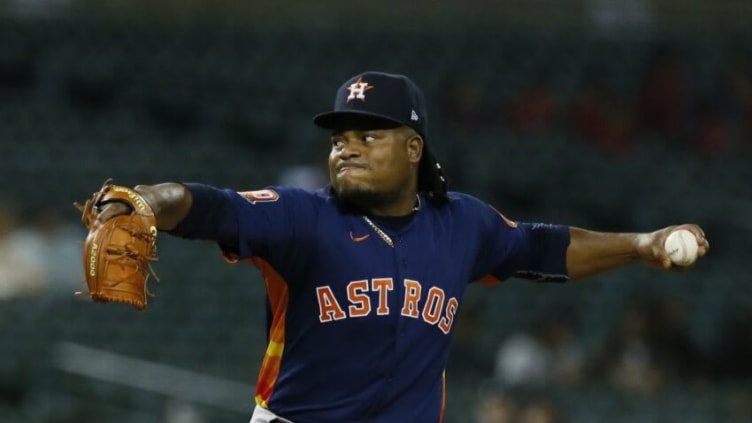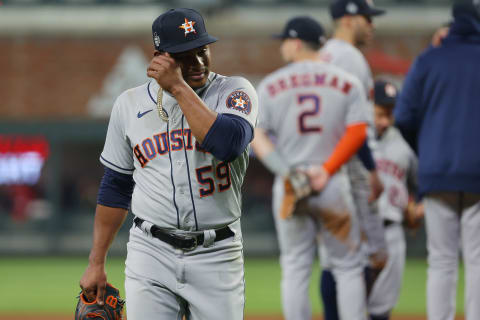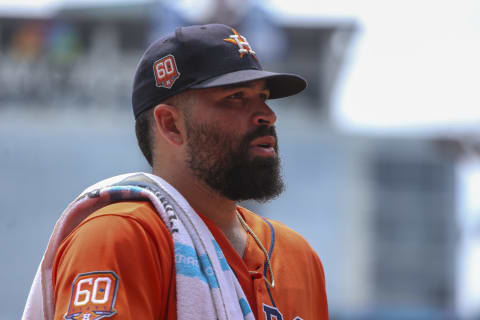Just how much better is the Houston Astros playoff rotation than the rest?

The Houston Astros continue to cruise to the No. 1 seed in the American League playoffs behind the best starting rotation in the American League.
This has been a season with little drama for Astros fans as the team has held a double digit lead in the division since since July 21.
So now it’s worth looking towards October and what will most likely be the Astros starting rotation.
Houston Astros have the best starting rotation in the American League heading into the playoffs
It’s not really a question of if the Astros have the best starting pitching in the American League but by how wide a margin. They lead the American League in starters wins with 72. The next closest is the Seattle Mariners with 51.
People say the win stat is overrated for pitchers but it does show that Astros starters go deep into games compared to other pitchers who are “two times through the batting order” starters who get pulled after five or six innings every time.
The Astros rotation earns its wins by averaging just a touch under six inning per start. By comparison the Tampa Bay Rays are last in innings per start with 4.6. These are the two different philosophies perfectly exemplified as the Rays stick to the two times through the order then hand it over to flame throwers in the bullpen strategy vs the Astros more traditional approach of “if they’re throwing well let ’em keep throwing.”
Beyond that the Astros starters lead the American League in ERA, quality starts, strikeouts, opponent batting average and are tied for the lead in WHIP with the New York Yankees.
So considering the Astros have what most would objectively agree is the best starting rotation in the American League if not all of baseball this will be a bit nitpicky when putting out the concerns for each starter.
We’re going to focus on the biggest positive and the biggest concern each Astros pitcher has going into the postseason in the order they would likely appear in the American League Division Series.
Starting with the obvious.

Houston Astros playoff roster: Justin Verlander
Biggest positive: Everything except…
Biggest negative: Health
Justin Verlander has defied age and Tommy John surgery in his 17th major league season by not just bouncing back from his elbow injury, but exploding back.
He’s considered the front runner for the American League Cy Young award leading the league in wins and winning percentage (16-3 record) and leading all of Major League baseball in ERA, WHIP and ERA+ which adjusts for a pitcher’s ballpark.
What’s even more impressive is comparing his numbers from this season to his 2011 season when he won both Cy Young and MVP.
2011 2.40 ERA, 172 ERA+, 0.920 WHIP in 34 starts.
2022 1.84 ERA, 208 ERA+, 0.855 WHIP in 24 starts.
Now granted Verlander threw 99 more innings in 2011 than he has so far in 2022. But the ERA and ERA+ are the best he’s had in any season in his 17 year career. And his WHIP is only second to his 2019 Cy Young campaign when he had a 0.803.
In both cases he won the Cy Young though he did throw over 200 innings in those seasons so we’ll see if his calf injury hurts his chances of winning.
More importantly, we’ll see if the calf injury prevents him from being part of the ALDS roster if he has any setbacks or not enough time to ramp his body to go seven innings strong.
The only thing that can stop Verlander from dominating in the postseason has nothing to do with his performance. It’s strictly will this calf injury be a minor blip on the season as the team has claimed it would be or will it stop him from either pitching deep into games or pitching at all.
If he’s healthy though, the Astros have a Hall of Fame ace opening up their bid for a second World Series title throwing as good as he’s ever thrown in his entire career.

Houston Astros playoff roster: Framber Valdez
Biggest Positive: Soft contact.
Biggest Negative: Keeping composure.
Framber Valdez is one start away from holding the Major League record for most consecutive quality starts in a single season by himself at 25. It would be a truly incredible feat that surpasses names like Jacob DeGrom and Bob Gibson and would put him two more quality starts away from the all-time record at 27.
His ability to induce soft contact is a big reason he can pitch deep into games as he can get quick outs on the ground and double plays when he does allow a runner keeping a low pitch count that lets him get into the sixth inning or later.
This year was his first all-star appearance and he is sneaking his way into the Cy Young conversation with how well he’s been pitching.
The only thing to worry about with Framber is the mental side of things and handling the postseason pressure.
He showed what he can do in game five of the ALCS against Boston in Fenway pitching eight innings allowing one run on three hits and a walk. Outside of that start though, the numbers in his first postseason playing in front of packed stadiums was far different than 2020 when he had only 10,000 people watching.
His start by start numbers are as follows:
Game 2 ALDS: 4.1 IP, four earned runs, seven hits and one walk.
Game 1 ALCS: 2.2 IP, two earned runs, six hits and three walks.
Game 1 World Series: 2 IP, five earned runs, eight hits and one walk.
Game 5 World Series: 2.2 IP, five earned runs, four hits and two walks.
That’s a 12.34 ERA in four starts with a WHIP of 2.74. Whatever he harnessed in game five of the ALCS he could not harness at any other time in the postseason and it wasn’t even close.
Framber seems to have turned a corner this year and has been dominant during this stretch of consecutive quality starts. The talent is there, it’s just a matter of consistency and doing it under the bright lights of October baseball.

Houston Astros playoff roster: Lance McCullers Jr
Biggest Positive: Postseason Experience
Biggest Negative: Endurance
It can’t be overstated how much Lance McCullers Jr.’s forearm injury hurt the Astros chances at winning their second World Series title in five years. Their rotation was the weakest point of the team and the fact they even got past the Boston Red Sox with how much their starting rotation imploded is a testament to what a great job the bullpen did handling the extended workload.
Similar to Framber Valdez this season McCullers Jr. put it all together last year finishing seventh in Cy Young voting, his first time receiving votes in the category.
He continued that into the postseason though ever so briefly due to his forearm injury, giving up one earned run in 10.2 innings alongside nine hits and three walks against nine strikeouts.
McCullers Jr. has been involved in big moments for the Astros including his famous 2017 ALCS game seven performance where he threw 24 straight breaking balls to the New York Yankees as part of his four inning save that sent the Astros to just their second World Series appearance ever.
The only thing to worry about is his endurance considering his late start to the year, but given that he went seven innings against the Los Angeles Angels in his most recent start surpassing the 100 pitch mark for the first time this year he should be fine come October.
It’s still worth monitoring how he handles the extra adrenaline and energy it takes pitching in the postseason considering he’ll have only made nine starts but perhaps that late start to the year will mean he’s rested and in mid-season form just in time for the playoffs.

Houston Astros playoff roster: Jose Urquidy
Biggest Positive: Throws strikes consistently
Biggest Negative: Prone to the big inning
The assumption is that Jose Urquidy will be the number four starter considering his postseason experience and strong second half to the 2022 season.
The best part of Urquidy’s game is also his downfall sometimes as he is always in the zone. He throws the most percentage of first pitch strikes of any Astros starter at 65 percent. The next closest is Justin Verlander at 62 percent. He also gives up the most contact on the team with the opponent making contact on 77.8 percent of his pitches.
It’s a great quality for a pitcher to throw strikes. Except when hitters are aware of this propensity they know to swing and if he’s catching too much of the plate the ball flies all over the ball park.
In his 11 starts when he’s given up three earned runs or more, six of those starts he’s given up all three (or more runs) in a solitary inning.
When Urquidy is on and hitting his spots in the zone it’s great. But if he has location issues it can lead to blow ups that can be a real gut punch if the score is zero zero in the fourth and then suddenly you’re down three or four nothing.
If Urquidy can learn how to limit damage when he’s in trouble that will be the biggest key to the Astros winning with him on the mound.
He has the lowest strikeout per nine innings on the team with 7.2. The next lowest is Framber at 8.5 and then not a solitary pitcher is under nine. On the flip side he’s tied for the lead in HR/9 with 1.4 alongside Luis Garcia and Phil Maton.
If Urquidy can reduce those long balls that will go a long way for the Astros and giving their offense a chance as opposed to having a repeat of the ALCS last year where it felt like the Astros were out of it before the game began.
The Astros rotation is in great shape overall with minimal concern. But if Verlander’s calf becomes a bigger issue, if Valdez loses his composure, if McCullers Jr. feels the effect of missing nearly a year of pitching and Urquidy can’t avoid the big inning that is the recipe for disaster to be worried about.
But even in the case of that perfect storm the Astros still have Cristian Javier, Luis Garcia and Hunter Brown. So in other words, there’s not a lot to worry about going into October.
Next. Houston Astros: Five Questions Entering September. dark